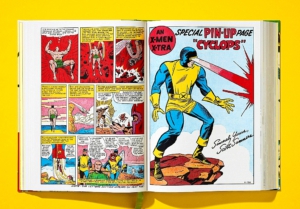With the fourth installment of the Marvel superheroes edition in XXL size, another one of Stan Lee’s impressive lines of comics is available now: Marvel’s “The X-Men.”
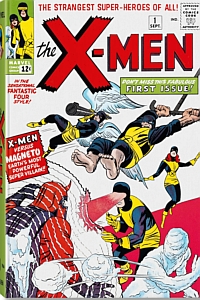 A name related to the eXtraordinary or simply X-tra powers the protagonists at hand possessed; without the help of lab accidents, misdirected sun rays or cosmic powers of any sort.
A name related to the eXtraordinary or simply X-tra powers the protagonists at hand possessed; without the help of lab accidents, misdirected sun rays or cosmic powers of any sort.
They were born that way and from a very young age on had to deal with their powers and uniqueness, one way or another; often they would endanger and accidentally injure or kill others.
However, that line of adventures was very different from publisher Martin Goodman’s publications so far. First, The X-Men, the literally “natural born” superheroes, were introduced as mutants, a term not entirely negative when it came up in 1963, the year of the line’s #1.
And they were nothing like the middle-aged scientists or the eccentric millionaire in his 40s, characters who usually spontaneously discovered their super powers.
Instead, The X-Men were teenagers, youngsters and young adults, so part of their characterization, in fact, were everyday teenager problems, too. That concept rather put them in one league with The Amazing Spider-Man and his particular comic book-buying audience.
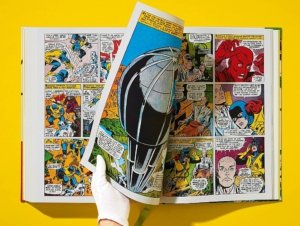
The mutants, among them characters such as Iceman, The Beast, Cyclops, Angel, Marvel Girl, would become household names for any comic book collector soon and would surface all over the Marvel Universe.
They became “The Strangest Super-Heroes of them all!” (Fans had to wait for their most popular member Wolverine until 1975, when he appeared in X-Men #94).
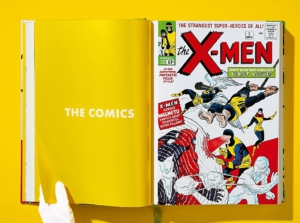 “Readers — young and old,” recalls author Nicieza, “Black, white, or plaid, regardless of their orientation, religious, or political beliefs — would see something of themselves reflected in the characters and their stories. Something to belong to, something to aspire toward: the hope and belief that people can set aside their differences and learn to live together.”
“Readers — young and old,” recalls author Nicieza, “Black, white, or plaid, regardless of their orientation, religious, or political beliefs — would see something of themselves reflected in the characters and their stories. Something to belong to, something to aspire toward: the hope and belief that people can set aside their differences and learn to live together.”
And as those particular teenagers would find themselves in trouble with the law more often than not, it took one Professor Xavier, a mutant himself with massive telepathic skills, to educate and unite them. And finally channel their powers for the good cause.
According to comic book logic, there had to be an evil-minded counterpart. This character would be Magneto, who led the “Brotherhood of Evil Mutants,” an outfit that would promote mutants’ rights and use violence against the rest of mankind. The “ordinary” humans, aware of the dangers of mutant powers, in turn would fight those and try to exterminate them.
Within this difficult political and ideological scenario, the X-Men were caught in countless 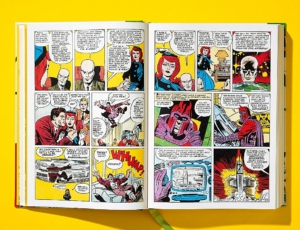 dilemmas of representing their status, insisting on their right to exist and at the same time having to encounter powerful enemies of their own kind and trying to establish areas of peace and diplomacy, while permanently protecting the planet and mankind as such from assaults by Magneto’s army and alien forces alike. Many more villains would enter the scene and expand the canon of Marvel super villains and their sidekicks:
dilemmas of representing their status, insisting on their right to exist and at the same time having to encounter powerful enemies of their own kind and trying to establish areas of peace and diplomacy, while permanently protecting the planet and mankind as such from assaults by Magneto’s army and alien forces alike. Many more villains would enter the scene and expand the canon of Marvel super villains and their sidekicks:
Scarlet Witch and Quicksilver, the Unstoppable Juggernaut, Jungle Dweller from the Savage Land, Ka-Zar, the Stranger, and Bolivar Trask to name but a few. Marvel’s creative visionaries Stan Lee and Jack Kirby in the first years were responsible for bringing the new comic book series on its way, artists Roy Thomas and Werner Roth would take over later. On July, 2, 1963 The X-Men #1 would be at the news stand announcing, “X-MEN VERSUS MAGNETO, EARTH’S MOST POWERFUL SUPER VILLAIN!”
Sixty years later, Marvel Comics Library. X-Men. Vol. 1. 1963–1966 covers the first 21 comics of Stan Lee’s line. This heavy work of the Eisner Award-winning series is ready to take you further into the vault of classic 1960s superhero comics.
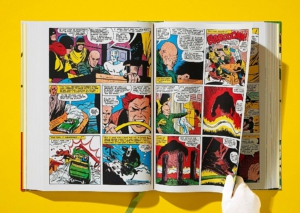 And looking back, Magneto of #1 was an easy job for Xavier’s followers, compared to what they had to handle in #21 and their continuous fight against Dominus.
And looking back, Magneto of #1 was an easy job for Xavier’s followers, compared to what they had to handle in #21 and their continuous fight against Dominus.
And besides presenting a lot of intrigue, master plans to destroy mankind and a lot of action, the X-Men series mirrored in part some of the struggles of contemporary American society. Such as questions of identity, social and cultural heritage, the struggle for civil rights/equal rights, representations of minorities in the media, violent uprisings, disillusionment of war veterans who would be forever changed and new enemies that would threaten the country and democracy in general.
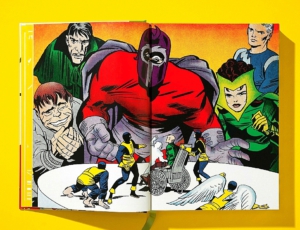 In that respect, popular culture and an age of change were very intensely represented in the books, and obviously that was one of the reasons why The X-Men became successful. Even if success had to wait until the 1970s, when members and locations became more international.
In that respect, popular culture and an age of change were very intensely represented in the books, and obviously that was one of the reasons why The X-Men became successful. Even if success had to wait until the 1970s, when members and locations became more international.
“The X-Men were always underdogs, slower to earn a monthly publishing schedule than other early Marvel launches, canceled after just a few years, forced into the ignominy of publishing reprints on a bimonthly schedule, but ultimately became the top-selling title in the industry for decades.”
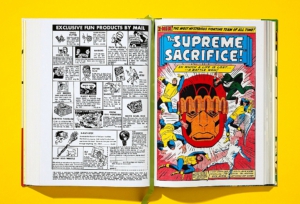 To recreate the sensation and physical enjoyment readers must have gotten when they entered the stories back then, Marvel as usual with the XXL Comics Library teamed up with the Certified Guaranty Company. Again, only the most pristine and best-preserved vintage comics were selected to serve as the source for an almost identical reprint of the original comic book page. In fact, many printing and coloring imperfections were corrected for this edition.
To recreate the sensation and physical enjoyment readers must have gotten when they entered the stories back then, Marvel as usual with the XXL Comics Library teamed up with the Certified Guaranty Company. Again, only the most pristine and best-preserved vintage comics were selected to serve as the source for an almost identical reprint of the original comic book page. In fact, many printing and coloring imperfections were corrected for this edition.
So any of the almost 600 pages of comic book action you will see and feel in this edition comes with the authentic vintage colors and naturally on special custom-made paper. The raw and unfinished character of the pulp page – here actually larger than the original artworks – will feel like it was manufactured decades ago and that is part of the package. The entire artwork, 10.29 lbs in size 1.0 x 15.6 in., presents 666 pages of serious comic book history. Again, there are two versions, the Famous First Edition of 5,000 numbered copies and the fancy Collector’s Edition that comes in 1,000 numbered copies. This one has an aluminum print cover with a leatherette-bound spine, has foil embossing, and is housed in a slipcase.
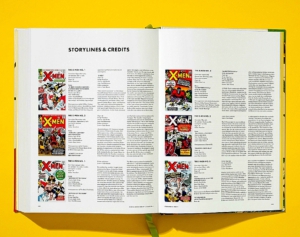 A short foreword, this time by Chris Claremont, the artist behind the modern X-Men stories and a brilliant 40 page essay by X-Men writer Fabian Nicieza will cover all the background of the first four years of this comic book line. Both editions are in English language only.
A short foreword, this time by Chris Claremont, the artist behind the modern X-Men stories and a brilliant 40 page essay by X-Men writer Fabian Nicieza will cover all the background of the first four years of this comic book line. Both editions are in English language only.
As usual, for this XXL series, there are tons of sketches, rare photographs and artwork, alternate covers, short biographies of the series’ inkers, writers, letterers, Marvel staff legends, as well as pictures of impossible to find memorabilia and promotional prints.
Another breathtaking volume, that again will excite the comic book fan community.
Review by Dr. A. Ebert © 2023
Stan Lee, Jack Kirby, Chris Claremont, Fabian Nicieza. Marvel Comics Library. X-Men. Vol. 1. 1963–1966. Taschen, 2023, 666 p., Famous First Edition, ISBN 978-3-8365-9454-7.
Stan Lee, Jack Kirby, Chris Claremont, Fabian Nicieza. Marvel Comics Library. X-Men. Vol. 1. 1963–1966. Taschen, 2023, 666 p., Collector’s Edition, ISBN 978-3-8365-9220-8.

